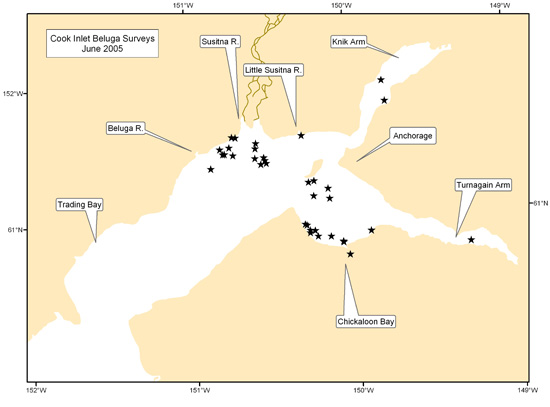Cetacean Assessment and Ecology Program
Cook Inlet Beluga Survey

Figure 2. Beluga sightings recorded during six surveys of upper Cook Inlet, Alaska, 31 May to 9 June 2005. |
Biologists from NMML, the NMFS Alaska Regional
Office, and U.S. Army Fort Richardson (Anchorage) surveyed Cook Inlet,
Alaska, for beluga whales (Delphinapterus leucas) 31 May to 9
June 2005, conducting 54.5 flight hours. Aerial survey procedures were
kept consistent with protocol used since 1993, when these annual surveys
began. An Aero Commander (a twin-engine, high-wing aircraft with bubble
windows) was flown at an altitude of 244 m (800 ft) to survey coastal
areas 1.4 km offshore around the entire inlet, including islands. Also,
1,363 km of offshore transects were flown. In total the survey covered
approximately 28% of the surface area of Cook Inlet but 100% of the
shoreline.
Paired, independent observers searched on the coastal
(left) side of the plane, where virtually all beluga sightings occur,
while a single observer was on the right. After finding beluga groups, a
series of aerial passes was made so that each observer could make a
minimum of four independent counts. This meant there were usually 16
counts of each group of whales each day. In addition, paired cameras
captured images that will later be examined for precise counts that can
be corrected for search time and applied to abundance estimates.
Beluga whales were found this year in the same areas
they have been seen most years since 1993 (Fig. 2, above): the delta of the Big
Susitna River, near the Little Su River, in Knik Arm, Turnagain Arm, and
Chickaloon Bay. Besides the usual locations, some groups were seen along
the shore of Fire Island. Similar to the distribution recorded over the
past decade, all beluga groups seen in 2005 were in the northernmost
parts of Cook Inlet, with no belugas seen south of Beluga River and
Point Possession. The standard counting index, which is the summary of
medians of counts of each whale group on each of the six survey days,
was 192—comparable to annual index numbers since 1998 (ranging from 174 to 217).
By Dave Rugh and Kim Goetz
>>>continued
 |

|
Quarterly sidebar
AFSC Quarterly Research Reports April-June 2005
Contents
Feature
ABL Reports
NMML Reports
RACE Reports
REFM Reports
Items
Quarterly Index
Quarterly Home
|

